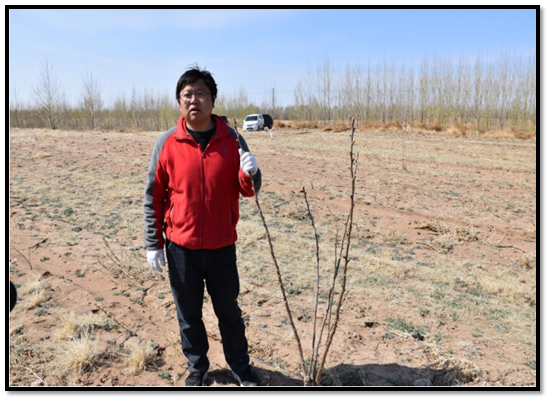- Add to favorites
- Set as home page
- January 4, 2022

Among the 10 woody oil plants as specified in the opinions of the General Office of the State Council, Shiny-leaved yellowhorn (Xanthoce sorbifolia Bunge) is usually deciduous subtrees or large shrubs. It is since 2014 that shiny-leaved yellowhorn (Xanthoce sorbifolia Bunge) has been introduced and planted in the Town of Yoshika Ro, Kailu County, Tongliao City, Inner Mongolia. After planting for several years, shiny-leaved yellowhorn (Xanthoce sorbifolia Bunge), which is featured by cold and drought resistance, dryness and leanness resistance, strong tillering ability and fewer pests, is a kind of excellent local economic tree that can fix sand and conserve soil, conserve water and improve ecological environment. However, so far, the yield has been low and unstable, with very low economic and ecological benefits.

Technical expert explained grafting technique for high yield on the spot
In order to implement the concept of “green mountains are gold mountains”, supported by “Special Fund for Qingshan Plan”, a special fund for environmental public welfare established jointly by China Environmental Protection Foundation and Meituan, the ecological poverty alleviation project was implemented by Chinese Society of Forestry in Liaofu village, Town of Yoshika Ro. Cui Tianpeng, the person in charge of the base for shiny-leaved yellowhorn (Xanthoce sorbifolia Bunge) of Chinese Academy of Forestry in Zhangwu, Liaoning Province, was employed to act as technical director. Two new varieties (variety right number is 20180121 and 20180122 respectively) i.e. “Zhongshi No.4” and “Zhongshi No.9” from Research Institute of Forestry CAF as authorized by National Forestry and Grassland Administration and National Park Administration, were selected as the materials due to their excellent characteristics such as apparent rapid growth, drought resistance, high oil content, high yield and early fruiting. A demonstration garden for high yield cultivation of shiny-leaved yellowhorn (Xanthoce sorbifolia Bunge) with an area of 100 mu has been built in Liaofu Village by means of grafting and cultivating new varieties of seedlings.
In order to allow more growers to have an access to and learn the grafting technique for high yield of shiny-leaved yellowhorn (Xanthoce sorbifolia Bunge), the Town of Yoshika Ro has invited technical specialists to popularize the knowledge about how to achieve high yield through Kwai’s online broadcast channel established by the Town.
It is reported that the predicted yield of rafted varieties in this project will be more than twice that of local control varieties and that the yield will 3-5 times of that of the control varieties since the fourth year (full productive age). Therefore, remarkable economic results will be achieved. In summary, the project will improve the ecological environment of desert area and border area, play a leading and exemplary role for farmers and herdsmen to seek self-development and eliminate poverty, promote the subsequent formation of local characteristic trade chain based on shiny-leaved yellowhorn (Xanthoce sorbifolia Bunge), and also promote the industrialization and sustainable development of woody oil resources of shiny-leaved yellowhorn (Xanthoce sorbifolia Bunge).